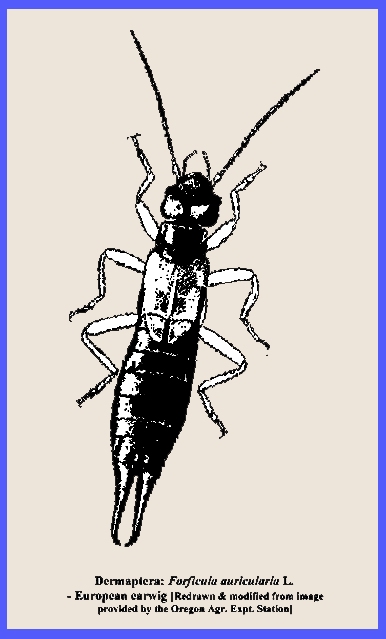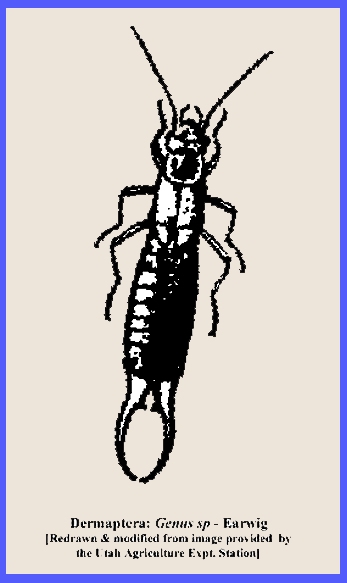File:
<dermaptera.htm> Indexes: < (Entomology), (Invertebrates), (General Index)> <Invertebrate
Bibliography> <Glossary> <Site Description> < Home>
|
Entomology: DERMAPTERA
1 Kingdom: Animalia, Phylum: Arthropoda Subphylum: Hexapoda: Class: Insecta: Order: Dermaptera (Contact) Please CLICK on underlined
categories to view and on included illustrations to enlarge: Depress
Ctrl/F to search for subject matter:
The Dermaptera, -- <Adults> & <Juveniles> -- The "earwigs" are insects with
chewing mouthparts, a ligula that is two-lobed, and forewings that are
modified to form short leathery tegmina, while their hind wings are large,
membranous and fan-shaped. They also
have unjointed cerci that are always modified into forceps. The metamorphosis is simple. When unfolded, the wing presents
the appearance of a half wheel, the 'spokes' radiating backwards from the
anterior border. The large posterior membranous portion corresponds to the
anal wing area of Orthoptera, that part analogous to the anterior area of the
latter order being greatly strengthened by the uniting of a number of
longitudinal veins. The hind wings have a distinct venation and fold along
transverse as well as longitudinal furrows, that differs from the Orthoptera.
The forceps are organs of defense and offence. In Labidura they are
used for seizing the small animals on which they feed (Borradaile
& Potts 1958). The appearance of gynandromorphs
is rather frequent in this group of insects. The European earwig, Forficula auricularia, is a
good example of this order that includes a number of small usually nocturnal
insects that are omnivorous in diet. The female lays the eggs in the soil,
remains with them until they hatch, and even protects the nymphs thereafter,
thereby showing maternal
care. In temperate zones
the males remain with their female mates in a ground nest throughout the
winter. Earwigs are gregarious and crawl
in large numbers onto food plants grown in home gardens. Some species rarely fly. They are mostly nocturnal and omnivorous. Earwigs rarely are an annoyance in
dwellings, but they can be serious pests of vegetable crops grown in home
gardens. Prevention is the best
approach to control by cleaning up piles of organic litter. Granular insecticides applied to the
ground will eliminate them, but this is not advisable because of possible
contamination of food crops through systemic action (Legner & Davis 1963). The use of poisoned baits is a preferred
approach as these can be placed in peripheral areas away from growing plants
(see Legner & Davis 1962). ---------------------------------- Dermaptera
--Biological Control Projects (1% of total
projects) European Earwig, Forficula auricularia L. <ch-45.htm> ------------------------------------------- Details of Insect
Taxonomic Groups Examples of beneficial species occur in almost every insect
order, and considerable information on morphology and habits has been
assembled. Therefore, the principal
groups of insect parasitoids and predators provide details that refer to the
entire class Insecta. These details
are available at <taxnames.htm>. ============== |


